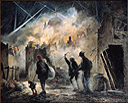
| Great Britain We Stuck Together Great Britain is in a special position because it was not occupied by the German Wehrmacht. Nevertheless, the War acted as a catalyst for a new beginning in the history of the nation, for it had united society. In the War the monarchy stood by its subjects; the nobility and the labour class squeezed side by side into the London air-raid shelters during the bombing attacks. This feeling of solidarity was reinforced by a huge propaganda apparatus which stressed and disseminated the image of a nation cemented together for the common cause. The populace was assured that they would survive the War and carry the victory in the end, if everyone stuck together. Most Britons saw themselves as the real liberators of Europe at the end of the War. This thought retains its validity until this day. While the memory of the World War gradually took a back seat in the 1960s and 1970s, the history of the War was once again commercially exploited during the era of Margaret Thatcher. The War became a cultural and national consumer product. At a time when politics sought a fundamental renewal of society and the economy, social consensus was called into question. The Prime Minister used the history industry to make this change at least intellectually tolerable. Even today one finds takers for almost anything that played a role in the past War and in the victory. |
|
| This painting by Netti Moon reduced almost all of the myths connected with the War to a common denominator: St. Paul's Cathedral and the home front, bomb-wrecked London and people caring for each other, in short: "The People's War". The Imperial War Museum has staged a similar pictorial world in its permanent exhibition. Every Briton understands this world and its symbolism. | |
| The film "Battle of Britain" from 1969 can be understood as a reconstruction of the air battle that took place in Great Britain. It attempts to present a comprehensive perspective and, alongside the military events, sheds light on the role of the home front. The true heroes there were ordinary people who never received a medal, but nevertheless engaged in a worthy battle. Moreover, the film brings to mind the national virtues which the wartime propaganda had underscored. It portrays the Britons as steadfast, good-natured and reserved people. However, the film also shows the superiority of the air force, which achieved victory through speed and manoeuvrability. The poster shows the city of London from the perspective of a pilot. It goes without saying that it is a view of the famous emblem of the indestructible will of the Britons: St. Paul's Cathedral. | |



